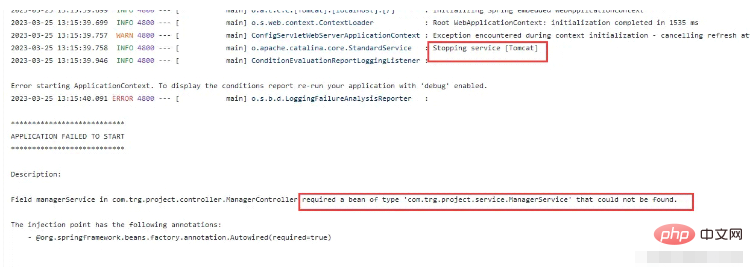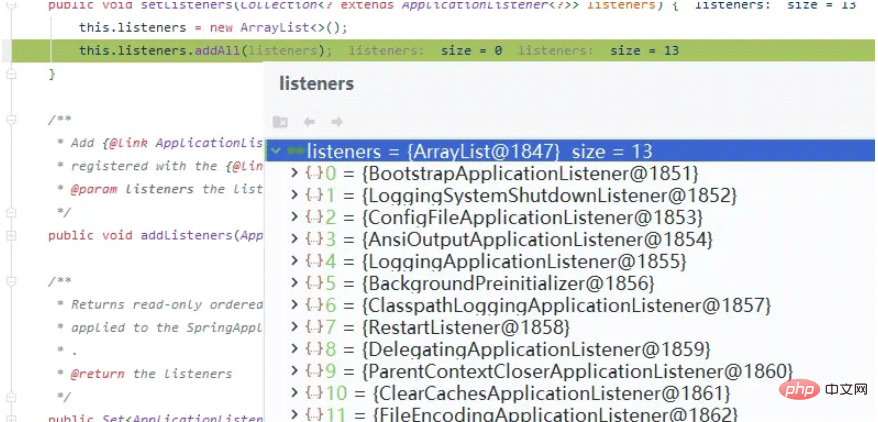SpringBoot 시작 원리는 무엇입니까?
入口
版本: 2.1.8.RELEASE
启动代码:
@SpringBootApplcation
public static void main(String[] args) {
SpringApplication.run(BlogAdminApplication.class, args);
System.out.println("======== admin start success... ==========");
}这里传入了两个参数,BlogAdminApplication当前类和args参数
我们点击进入run方法查看
public static ConfigurableApplicationContext run(Class<?> primarySource, String... args) {
return run(new Class[]{primarySource}, args);
}这里是将我们写的启动类传入到了Class[]数组中,这步就是个单纯的参数转换。
探讨primarySource参数
那么问题是primarySource能接受的类型是啥样的,是不是什么类都可以接受,带着这个疑问,我们做一个测试,把这个参数给换成一个别的类呢,ManagerController类是一个我写的接口类
@SpringBootApplication
public class BlogProjectApplication {
public static void main(String[] args) {
SpringApplication.run(ManagerController.class, args);
System.out.println("======== admin start success... ==========");
}
}控制台打印
org.springframework.context.ApplicationContextException: Unable to start web server; nested exception is org.springframework.context.ApplicationContextException: Unable to start ServletWebServerApplicationContext due to missing ServletWebServerFactory bean.
提示不能启动服务,提示缺少了ServletWebServerFactory bean 点进这个类看下
@FunctionalInterface
public interface ServletWebServerFactory {
WebServer getWebServer(ServletContextInitializer... initializers);
}他被FunctionalInterface标注了,是一个函数式接口,只有一个getWebServer方法,用来获取webServer的 看下他的实现类,

这不就是提示我们缺少启动的服务容器么,说的直白点,我的理解就是他缺少可以运行的容器,我们知道,没有使用springboot项目之前,我们的项目都是跑在tomcat容器上的,当然也有使用Jetty容器的。再者,我们知道SpringBoot是对tomcat进行了内置。而SpringBoot不仅仅是只有内置了tomcat,而且还内置了好多的东西,比如我们经常使用的mq、redis等等一系列的东西,这个我们可以在spring.factories配置文件中看到,这个文件位于如下位置

大概内容有下,篇幅有限,就不一一列举了。
省略。。。 org.springframework.boot.autoconfigure.EnableAutoConfiguration=\ org.springframework.boot.autoconfigure.admin.SpringApplicationAdminJmxAutoConfiguration,\ org.springframework.boot.autoconfigure.aop.AopAutoConfiguration,\ org.springframework.boot.autoconfigure.amqp.RabbitAutoConfiguration,\ org.springframework.boot.autoconfigure.batch.BatchAutoConfiguration,\ org.springframework.boot.autoconfigure.cache.CacheAutoConfiguration,\ 省略。。。
那么回过头来,我们再看下这个问题,这些个类是如何被加载进来的,我们知道SpingBoot有个注解是开启自动注解的@EnableAutoConfiguration,他就干这个事情的。他能够激活SpringBoot内建和自定义组件的自动装配特性。
那么,知道了这些,我们把这个之前修改后的类给改造一下,加上注解@EnableAutoConfiguration,看下执行效果。
@RestController
@RequestMapping("project/manager")
@EnableAutoConfiguration
public class ManagerController extends AbstractController {运行如下

从打印信息就能知道,服务器有了,只不过下面报错,提示找不到bean,那这不就简单了么,他是不是就是没有扫描到我们的包么,这里就其实可以在配置扫描包的注解继续测试,我就懒的不测试了,直接去看@SpringBootApplication注解
@Target({ElementType.TYPE})
@Retention(RetentionPolicy.RUNTIME)
@Documented
@Inherited
@SpringBootConfiguration
@EnableAutoConfiguration
//
@ComponentScan(
excludeFilters = {@Filter(
type = FilterType.CUSTOM,
classes = {TypeExcludeFilter.class}
), @Filter(
type = FilterType.CUSTOM,
classes = {AutoConfigurationExcludeFilter.class}
)}
)
public @interface SpringBootApplication {@SpringBootApplication这个注解其实就是一个组合注解,里面包含了
元注解:用来标注他是一个注解的,jdk自带的
@SpringBootConfiguration:集成自@Configuration,表示是一个配置类
@EnableAutoConfiguration:激活SpringBoot内建和自定义组件的自动装配特性
@ComponentScan:扫描注解,添加了排除参数,指定排除了一些类
通过这里的实验,我们可以得出结论:
primarySource参数能接收的类是一个配置类,同时要把符合扫描规则的类装配到spring容器中,并且对SpringBoot内置的一些类进行自动扫描到,而这里的@SpringBootApplication注解就是把这些特性都整合到了一起,作为了一个引导类而已。那么说白了,primarySource他接受的其实就是一个配置类。
关于注解详细知识的话,这里就聊这么多了,后面再详细聊。
args参数
args是Java命令行参数,我们在DOS中执行Java程序的时候使用“java 文件名 args参数”。args这个数组可以接收到这些参数。这个是个基础常识了。
以下我们将继续跟踪源码进行分析
我们继续追run()方法
public static ConfigurableApplicationContext run(Class<?>[] primarySources, String[] args) {
return (new SpringApplication(primarySources)).run(args);
}这个方法干了两个事情:
1、new SpringApplication()来创建对象
2、通过创建后的对象,调用对象里面的run()方法
以下我们将从这两个地方进行分析,本篇就先研究第一个
创建对象
我们先看下他是怎么创建对象的,创建了哪些对象,
public SpringApplication(Class<?>... primarySources) {
this((ResourceLoader)null, primarySources);
}
public SpringApplication(ResourceLoader resourceLoader, Class<?>... primarySources) {
//资源加载器
this.resourceLoader = resourceLoader;
//断言
Assert.notNull(primarySources, "PrimarySources must not be null");
//对primarySources进行存储到LinkedHashSet
this.primarySources = new LinkedHashSet<>(Arrays.asList(primarySources));
//1、推断web应用类别
this.webApplicationType = WebApplicationType.deduceFromClasspath();
//2、加载Spring应用上下文初始化
setInitializers((Collection) getSpringFactoriesInstances(ApplicationContextInitializer.class));
//3、加载Spring应用事件监听器
setListeners((Collection) getSpringFactoriesInstances(ApplicationListener.class));
//4、推断应用引导类
this.mainApplicationClass = deduceMainApplicationClass();
}下面研究下主要流程部分
1、推断web应用类别
推断web应用类型属于SpringBoot应用web类型的初始化过程。而该类型也可在SpringApplication构造后,run方法执行之前,通过setWebApplicationType(WebApplicationType webApplicationType)方法进行调整。
在推断Web应用类型的过程中,由于当前Spring应用上下文尚未准备(可在代码执行顺序中看到),所以实现采用的是检查检查当前ClassLoader下基准Class的存在性判断。
上源码
this.webApplicationType = WebApplicationType.deduceFromClasspath();
private static final String[] SERVLET_INDICATOR_CLASSES = { "javax.servlet.Servlet",
"org.springframework.web.context.ConfigurableWebApplicationContext" };
private static final String WEBMVC_INDICATOR_CLASS = "org.springframework." + "web.servlet.DispatcherServlet";
private static final String WEBFLUX_INDICATOR_CLASS = "org." + "springframework.web.reactive.DispatcherHandler";
private static final String JERSEY_INDICATOR_CLASS = "org.glassfish.jersey.servlet.ServletContainer";
private static final String SERVLET_APPLICATION_CONTEXT_CLASS = "org.springframework.web.context.WebApplicationContext";
private static final String REACTIVE_APPLICATION_CONTEXT_CLASS = "org.springframework.boot.web.reactive.context.ReactiveWebApplicationContext";
static WebApplicationType deduceFromClasspath() {
//当DispatcherHandler存在,且DispatcherServlet、ServletContainer两个不存在时;换言之,SpringBoot仅依赖WebFlux存在时,此时的应用类型为REACTIVE
if (ClassUtils.isPresent(WEBFLUX_INDICATOR_CLASS, null) && !ClassUtils.isPresent(WEBMVC_INDICATOR_CLASS, null)
&& !ClassUtils.isPresent(JERSEY_INDICATOR_CLASS, null)) {
return WebApplicationType.REACTIVE;
}
//当Servlet和ConfigurableWebApplicationContext均不存在时,当前应用为非Web应用,即WebApplicationType.NONE,因为这些API均是Spring Web MVC必须的依赖
for (String className : SERVLET_INDICATOR_CLASSES) {
if (!ClassUtils.isPresent(className, null)) {
return WebApplicationType.NONE;
}
}
//当WebFlux和Spring Web MVC同时存在时,Web应用类型同样是Servlet Web,即WebApplicationType.SERVLET
return WebApplicationType.SERVLET;
}2、加载Spring应用上下文初始化
setInitializers((Collection) getSpringFactoriesInstances(ApplicationContextInitializer.class));
此过程包含两个动作,依次为getSpringFactoriesInstances(ApplicationContextInitializer.class)和setInitializers方法。 先看第一个过程
private <T> Collection<T> getSpringFactoriesInstances(Class<T> type) {
return getSpringFactoriesInstances(type, new Class<?>[] {});
}
private <T> Collection<T> getSpringFactoriesInstances(Class<T> type, Class<?>[] parameterTypes, Object... args) {
//获取类加载器
ClassLoader classLoader = getClassLoader();
// Use names and ensure unique to protect against duplicates
//加载了META-INF/spring.factories资源中配置的ApplicationContextInitializer实现类名单。
Set<String> names = new LinkedHashSet<>(SpringFactoriesLoader.loadFactoryNames(type, classLoader));
//初始化
List<T> instances = createSpringFactoriesInstances(type, parameterTypes, classLoader, args, names);
AnnotationAwareOrderComparator.sort(instances);
return instances;
}此处使用了Spring工厂加载机制方法SpringFactoriesLoader.loadFactoryNames(type, classLoader)。加载了META-INF/spring.factories资源中配置的ApplicationContextInitializer实现类名单。

加载完成后使用createSpringFactoriesInstances方法对其进行初始化。
private <T> List<T> createSpringFactoriesInstances(Class<T> type, Class<?>[] parameterTypes,
ClassLoader classLoader, Object[] args, Set<String> names) {
List<T> instances = new ArrayList<>(names.size());
for (String name : names) {
try {
//从类加载器中获取指定类
Class<?> instanceClass = ClassUtils.forName(name, classLoader);
//判断instanceClass是不是type的子类
Assert.isAssignable(type, instanceClass);
//根据以上获取的类名创建类的实例
Constructor<?> constructor = instanceClass.getDeclaredConstructor(parameterTypes);
//排序
T instance = (T) BeanUtils.instantiateClass(constructor, args);
instances.add(instance);
}
catch (Throwable ex) {
throw new IllegalArgumentException("Cannot instantiate " + type + " : " + name, ex);
}
}
return instances;
}3、加载Spring应用事件监听器
setListeners((Collection) getSpringFactoriesInstances(ApplicationListener.class));
此过程与2、加载上下文初始化基本类似。 只不过初始化的对象类型变成了ApplicationListener.class,setListeners方法也只是赋值而已
public void setListeners(Collection<? extends ApplicationListener<?>> listeners) {
this.listeners = new ArrayList<>();
this.listeners.addAll(listeners);
}
4、推断应用引导类
this.mainApplicationClass = deduceMainApplicationClass();
private Class<?> deduceMainApplicationClass() {
try {
StackTraceElement[] stackTrace = new RuntimeException().getStackTrace();
for (StackTraceElement stackTraceElement : stackTrace) {
if ("main".equals(stackTraceElement.getMethodName())) {
return Class.forName(stackTraceElement.getClassName());
}
}
}
catch (ClassNotFoundException ex) {
// Swallow and continue
}
return null;
}这里使用到了new RuntimeException().getStackTrace()来获取堆栈信息,找到调用执行的main方法,从而确定他的类。
这里有个疑问:他不是传了primarySources数组,里面包含了类名么,怎么还用堆栈的方式去获取,此外,这里的堆栈获取也只能获取一个调用的主main方法,他为啥还要传一个Class数组呢?
具体咋获取的,可以追下源码,一直跟踪他的父类Throwable,找到如下代码
/**
* Fills in the execution stack trace. This method records within this
* {@code Throwable} object information about the current state of
* the stack frames for the current thread.
*
* <p>If the stack trace of this {@code Throwable} {@linkplain
* Throwable#Throwable(String, Throwable, boolean, boolean) is not
* writable}, calling this method has no effect.
*
* @return a reference to this {@code Throwable} instance.
* @see java.lang.Throwable#printStackTrace()
*/
public synchronized Throwable fillInStackTrace() {
if (stackTrace != null ||
backtrace != null /* Out of protocol state */ ) {
fillInStackTrace(0);
stackTrace = UNASSIGNED_STACK;
}
return this;
}
private native Throwable fillInStackTrace(int dummy);这里最后调用了native本地方法,去爬取线程堆栈信息,为运行时栈做一份快照。

通过这个图片,可以看到整个方法的调用链,从下往上看哦
위 내용은 SpringBoot 시작 원리는 무엇입니까?의 상세 내용입니다. 자세한 내용은 PHP 중국어 웹사이트의 기타 관련 기사를 참조하세요!

핫 AI 도구

Undresser.AI Undress
사실적인 누드 사진을 만들기 위한 AI 기반 앱

AI Clothes Remover
사진에서 옷을 제거하는 온라인 AI 도구입니다.

Undress AI Tool
무료로 이미지를 벗다

Clothoff.io
AI 옷 제거제

AI Hentai Generator
AI Hentai를 무료로 생성하십시오.

인기 기사

뜨거운 도구

메모장++7.3.1
사용하기 쉬운 무료 코드 편집기

SublimeText3 중국어 버전
중국어 버전, 사용하기 매우 쉽습니다.

스튜디오 13.0.1 보내기
강력한 PHP 통합 개발 환경

드림위버 CS6
시각적 웹 개발 도구

SublimeText3 Mac 버전
신 수준의 코드 편집 소프트웨어(SublimeText3)

뜨거운 주제
 7515
7515
 15
15
 1378
1378
 52
52
 79
79
 11
11
 53
53
 19
19
 19
19
 64
64
 Springboot가 Jasypt를 통합하여 구성 파일 암호화를 구현하는 방법
Jun 01, 2023 am 08:55 AM
Springboot가 Jasypt를 통합하여 구성 파일 암호화를 구현하는 방법
Jun 01, 2023 am 08:55 AM
Jasypt 소개 Jasypt는 개발자가 최소한의 노력으로 프로젝트에 기본 암호화 기능을 추가할 수 있게 해주며 암호화 작동 방식에 대한 깊은 이해가 필요하지 않은 단방향 및 양방향 암호화에 대한 높은 보안을 제공합니다. 표준 기반 암호화 기술. 비밀번호, 텍스트, 숫자, 바이너리 암호화... Spring 기반 애플리케이션, 개방형 API와의 통합에 적합하며 모든 JCE 공급자와 함께 사용할 수 있습니다... 다음 종속성을 추가합니다: com.github.ulisesbocchiojasypt-spring-boot-starter2. Jasypt의 이점은 코드가 유출되더라도 데이터 소스를 보장할 수 있어 시스템 보안을 보호합니다.
 SpringBoot가 Redisson을 통합하여 지연 대기열을 구현하는 방법
May 30, 2023 pm 02:40 PM
SpringBoot가 Redisson을 통합하여 지연 대기열을 구현하는 방법
May 30, 2023 pm 02:40 PM
사용 시나리오 1. 주문이 성공적으로 이루어졌으나 30분 이내에 결제가 이루어지지 않았습니다. 결제 시간이 초과되어 주문이 자동으로 취소되었습니다. 2. 주문이 서명되었으며 서명 후 7일 동안 평가가 수행되지 않았습니다. 주문 시간이 초과되어 평가되지 않으면 시스템은 기본적으로 긍정적 평가로 설정됩니다. 3. 판매자가 5분 동안 주문을 받지 않으면 주문이 취소됩니다. 문자 메시지 알림이 전송됩니다... 지연이 길고 실시간 성능이 낮은 시나리오의 경우 작업 예약을 사용하여 정기적인 폴링 처리를 수행할 수 있습니다. 예: xxl-job 오늘은 다음을 선택하겠습니다.
 Redis를 사용하여 SpringBoot에서 분산 잠금을 구현하는 방법
Jun 03, 2023 am 08:16 AM
Redis를 사용하여 SpringBoot에서 분산 잠금을 구현하는 방법
Jun 03, 2023 am 08:16 AM
1. Redis는 분산 잠금 원칙과 분산 잠금이 필요한 이유를 구현합니다. 분산 잠금에 대해 이야기하기 전에 분산 잠금이 필요한 이유를 설명해야 합니다. 분산 잠금의 반대는 독립형 잠금입니다. 다중 스레드 프로그램을 작성할 때 공유 변수를 동시에 작동하여 발생하는 데이터 문제를 방지하기 위해 일반적으로 잠금을 사용하여 공유 변수를 상호 제외합니다. 공유 변수의 사용 범위는 동일한 프로세스에 있습니다. 동시에 공유 리소스를 운영해야 하는 여러 프로세스가 있는 경우 어떻게 상호 배타적일 수 있습니까? 오늘날의 비즈니스 애플리케이션은 일반적으로 마이크로서비스 아키텍처입니다. 이는 하나의 애플리케이션이 여러 프로세스를 배포한다는 의미이기도 합니다. 여러 프로세스가 MySQL에서 동일한 레코드 행을 수정해야 하는 경우 잘못된 작업으로 인해 발생하는 더티 데이터를 방지하려면 배포가 필요합니다. 현재 소개할 스타일은 잠겨 있습니다. 포인트를 얻고 싶다
 springboot가 파일을 jar 패키지로 읽은 후 파일에 액세스할 수 없는 문제를 해결하는 방법
Jun 03, 2023 pm 04:38 PM
springboot가 파일을 jar 패키지로 읽은 후 파일에 액세스할 수 없는 문제를 해결하는 방법
Jun 03, 2023 pm 04:38 PM
Springboot가 파일을 읽지만 jar 패키지로 패키징한 후 최신 개발에 액세스할 수 없습니다. springboot가 파일을 jar 패키지로 패키징한 후 파일을 읽을 수 없는 상황이 발생합니다. 그 이유는 패키징 후 파일의 가상 경로 때문입니다. 유효하지 않으며 읽기를 통해서만 액세스할 수 있습니다. 파일은 리소스 publicvoidtest(){Listnames=newArrayList();InputStreamReaderread=null;try{ClassPathResourceresource=newClassPathResource("name.txt");Input 아래에 있습니다.
 여러 테이블을 추가하기 위해 SQL 문을 사용하지 않고 Springboot+Mybatis-plus를 구현하는 방법
Jun 02, 2023 am 11:07 AM
여러 테이블을 추가하기 위해 SQL 문을 사용하지 않고 Springboot+Mybatis-plus를 구현하는 방법
Jun 02, 2023 am 11:07 AM
Springboot+Mybatis-plus가 다중 테이블 추가 작업을 수행하기 위해 SQL 문을 사용하지 않을 때 내가 직면한 문제는 테스트 환경에서 생각을 시뮬레이션하여 분해됩니다. 매개 변수가 있는 BrandDTO 개체를 생성하여 배경으로 매개 변수 전달을 시뮬레이션합니다. Mybatis-plus에서 다중 테이블 작업을 수행하는 것은 매우 어렵다는 것을 Mybatis-plus-join과 같은 도구를 사용하지 않으면 해당 Mapper.xml 파일을 구성하고 냄새나고 긴 ResultMap만 구성하면 됩니다. 해당 SQL 문을 작성합니다. 이 방법은 번거로워 보이지만 매우 유연하며 다음을 수행할 수 있습니다.
 SpringBoot와 SpringMVC의 비교 및 차이점 분석
Dec 29, 2023 am 11:02 AM
SpringBoot와 SpringMVC의 비교 및 차이점 분석
Dec 29, 2023 am 11:02 AM
SpringBoot와 SpringMVC는 모두 Java 개발에서 일반적으로 사용되는 프레임워크이지만 둘 사이에는 몇 가지 분명한 차이점이 있습니다. 이 기사에서는 이 두 프레임워크의 기능과 용도를 살펴보고 차이점을 비교할 것입니다. 먼저 SpringBoot에 대해 알아봅시다. SpringBoot는 Spring 프레임워크를 기반으로 하는 애플리케이션의 생성 및 배포를 단순화하기 위해 Pivotal 팀에서 개발되었습니다. 독립 실행형 실행 파일을 구축하는 빠르고 가벼운 방법을 제공합니다.
 SpringBoot가 Redis를 사용자 정의하여 캐시 직렬화를 구현하는 방법
Jun 03, 2023 am 11:32 AM
SpringBoot가 Redis를 사용자 정의하여 캐시 직렬화를 구현하는 방법
Jun 03, 2023 am 11:32 AM
1. RedisAPI 기본 직렬화 메커니즘인 RedisTemplate1.1을 사용자 정의합니다. API 기반 Redis 캐시 구현은 데이터 캐싱 작업에 RedisTemplate 템플릿을 사용합니다. 여기서 RedisTemplate 클래스를 열고 클래스의 소스 코드 정보를 봅니다. 키 선언, 값의 다양한 직렬화 방법, 초기 값은 비어 있음 @NullableprivateRedisSe
 springboot에서 application.yml의 값을 얻는 방법
Jun 03, 2023 pm 06:43 PM
springboot에서 application.yml의 값을 얻는 방법
Jun 03, 2023 pm 06:43 PM
프로젝트에서는 일부 구성 정보가 필요한 경우가 많습니다. 이 정보는 테스트 환경과 프로덕션 환경에서 구성이 다를 수 있으며 실제 비즈니스 상황에 따라 나중에 수정해야 할 수도 있습니다. 이러한 구성은 코드에 하드 코딩할 수 없습니다. 예를 들어 이 정보를 application.yml 파일에 작성할 수 있습니다. 그렇다면 코드에서 이 주소를 어떻게 얻거나 사용합니까? 2가지 방법이 있습니다. 방법 1: @Value 주석이 달린 ${key}를 통해 구성 파일(application.yml)의 키에 해당하는 값을 가져올 수 있습니다. 이 방법은 마이크로서비스가 상대적으로 적은 상황에 적합합니다. 프로젝트, 업무가 복잡할 때는 논리




